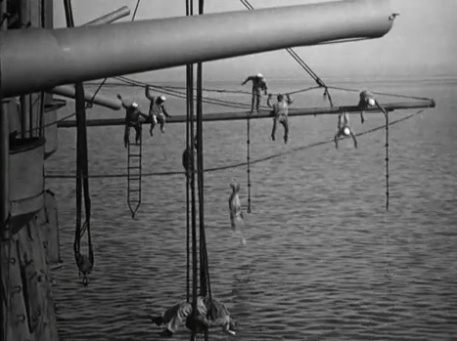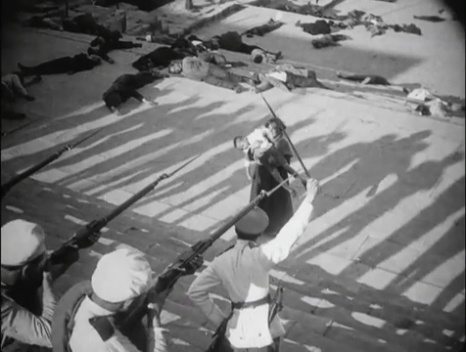
Comrade overboard! Potemkin sailors leap into the water to save the leader of the mutiny against tyrannical Tsarist officers in Eisenstein’s remarkable Soviet propaganda film.
Workers of the world unite! In this entry we discuss Sergei Eisenstein’s Battleship Potemkin (Bronenosets Potemkin), a film that has been considered a major classic pretty much since its premier in 1925. The 2012 Sight & Sound poll represents the first time in the poll’s 60 year history that Potemkin has not been in the Top 10, and it missed out by just one vote. So it carries a lot of critical baggage as an essential film. The movie itself centers on the true story of a mutiny aboard a Russian naval vessel during the revolutionary uprisings of 1905 and the (fictional) brutal reprisal by Tsarist troops against the mutineers’ supporters in the city of Odessa. Like most Russian films made in the aftermath of the Russian civil war (1917-1922), Potemkin is very much a piece of communist propaganda, but its revolutionary use of montage is credited with redefining the way in which stories are told on the silver screen. (69 min.)
S. – I have to say I was quite dubious going in that this was a film I would enjoy. Call me crazy but a silent propaganda film about a Russian battleship was not filling me with happy anticipation. However, my fear that I was in for an evening of boredom was quickly allayed. This movie is engaging, beautifully shot and comes with a climax that had me on the edge of my seat.
J. – I’d been meaning to see this film for years, but almost purely out of a sort of academic curiosity. I’d never really dipped too heavily into the silent era and was always a bit reticent to do so, but this movie comes up again and again in writing on film. Man, am I glad we got around to watching it. I was really surprised by how genuinely thrilling it was, particularly that climax that you mentioned and which I’m sure we’ll return to. I think what really struck me was how sophisticated the editing was. The camera itself rarely moves throughout the movie, but the cuts are so rapid and the camera angles so varied and interesting that it gives the illusion that the camera is moving all over the place–that it’s almost omnipresent. Compared to Intolerance, where the camera tends to linger for extended periods, Potemkin is almost all quick cuts, many nearly as quick as a modern action flick. It really gave everything a great dynamism and injected scenes with a great deal of emotion without quite as much of the silent movie overacting (although there’s still a fair share of that).
S. – The camera work is remarkable. There is a lot of experimentation going on but this does not distract from the story, rather it adds another layer. I feel that Eisenstein’s understanding of the emotional power of film was effectively displayed throughout. Many of my favorite scenes were those without people in them; the inner workings of the ship or the ocean whipping past the hull, always a sense of movement and action. Some of the acting was quite exaggerated but I soon got caught up in the story and felt it added to the heightened emotion of the situation. The tension generated in the film was palpable and at many times I truly did not know what was going to happen. One of the earlier scenes where members of the ships crew are on the brink of being executed for complaining about the borscht was a clear signal that I was in for a harrowing ride.
J. – Having done a bit of reading up on early Soviet film lately, I note that it is frequently mentioned that Eisenstein eschewed the use of lead actors in his early films in favor of the masses being the heroes (as befits a newly established communist system). And that observation is spot on. It is crowds of sailors and crowds of Odessa residents who serve as the good guys in this film, but even more than that, the only people who are set out as individuals are martyrs to the cause and the evil Tsarist officers, which I found interesting. I complained in our last post about how Intolerance‘s French story didn’t allow me to connect with the characters, so I didn’t really care about their actions and fates, but Eisenstein offers almost no connections — almost no characters at all, for that matter — and yet managed to get me fully invested in the story and emotional currents of the picture. That can’t be an easy thing to accomplish.
S. – The unfairness of the sailors’ situation was clearly represented, it is such a basic response to bridle against the callous disregard of the officers that I found myself fully on side with the crew despite there being no individual characters put forward as is typical in a film. I agree that this unusual tactic was done to great effect. A very similar scenario is played out again but in a larger scale on the Odessa steps, this time with ordinary citizens the target of the brutal Tsarist tyrants. The contrast between the happy, wholesome townsfolk and the murderous, robotic soldiers painted a harsh and memorable picture of good being crushed by evil.

A woman confronts the relentless line of soldiers on the Odessa steps to plead for the life of her wounded son. Mercy is not to be found from the old regime.
J. – Ah yes, the famous Odessa steps sequence, which has been referenced in so many movies since, particularly the train station shootout in Brian DePalma’s The Untouchables. (I think it was Sam Simon of The Simpsons who said, “If you steal from a black-and-white movie, it’s not theft, it’s an homage.”) That scene is truly shocking, even 85+ years on. The violence is very stark and intense, and the faceless soldiers marching in lockstep down those endless stairs are terrifying. I read that the violence in this scene got the movie banned in Britain until 1954, and then when it was finally released it had an X rating! The violence managed to be bloody and over the top (like the famous baby carriage plummeting down the stairs) without being gratuitous. By that I mean that it was always serving the aims of the film and really set the stage for the climatic confrontation between the mutinous battleship and the rest of the fleet. We had a bitter taste of the implacable cruelty of the military, and consequently we knew the stakes couldn’t be higher.
S. – And what a climax! If we had any doubts about the integrity of our shipbound rebels they were washed away in the blood on the Odessa steps. Sorry for the hyperbole but it really is that kind of film. The intense cutting between the Battleship Potemkin and the crew in the opposing fleet as they faced each other down accompanied by a pulsating musical score created a breathless tension. Factoring in that this was obviously no Hollywood flick a happy ending was not guaranteed (although a better knowledge of Russian history would likely have provided some comfort). I thoroughly enjoyed this movie and have discovered that I am likely an ideal victim for any propaganda machine that can shoot a beautiful film.
J. – As am I, comrade. As am I. The climax bowled me over. The way the tempo of the cuts and the score relentlessly accelerate like an engine building up to ramming speed had the same effect on my pulse. I’ve seen some people refer to the ending as an anticlimax, but I think that’s way off base. After the Odessa steps and the endlessly intensifying buildup to the confrontation with the fleet, the celebratory ending is the only way to go. A drawn out naval battle or a grim martyrdom, those would have been anticlimactic.
I thoroughly enjoyed Battleship Potemkin as well. I suppose the highest compliment I can pay it is that it is the reason we’ve taken on this project to watch 250 movies and therefore the reason this blog even exists. Not too shabby.
S. – Totally spot on, J. I was going to write that I am so pleased that this project got us to watch this film but then realised that is not how it went down. Seeing Battleship Potemkin was the impetus for discovering more hidden gems that I previously would dismiss as not my cup of tea, it was the first splendid step into the Sight & Sound repository.

Pingback: Review of Sergei Eisenstein’s Battleship Potemkin, a 1925 Russian Pioneering Film | Film Louvre